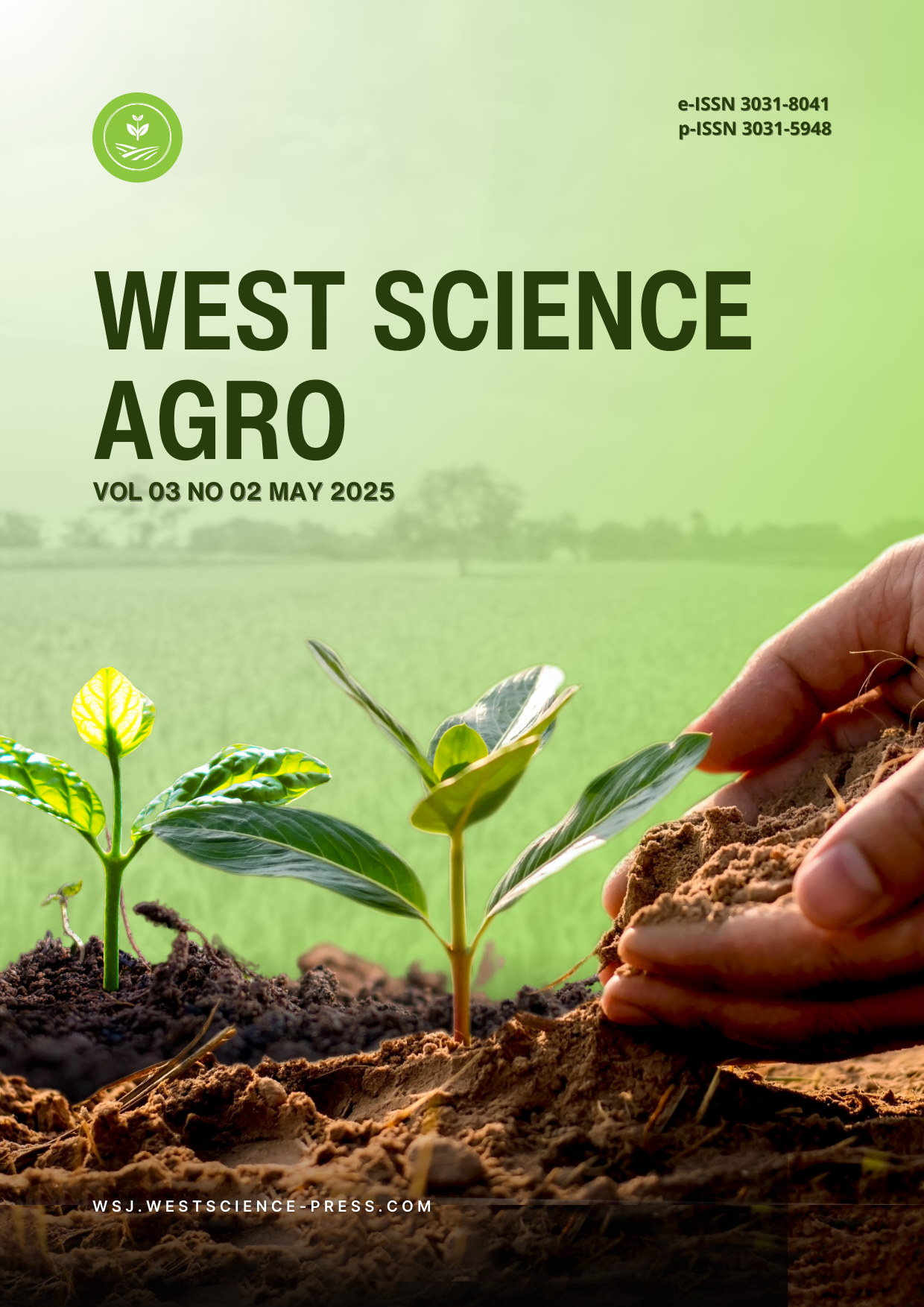Analysis of the Impact of Agroindustry, Packaging Technology, and Local Product Branding on the Value Added of Banana Products in Makassar
DOI:
https://doi.org/10.58812/wsa.v3i02.1922Keywords:
Agroindustry, Packaging Technology, Local Product Branding, Value Added, Banana ProductsAbstract
This study investigates the impact of agroindustry, packaging technology, and local product branding on the value added to banana products in Makassar. Using a quantitative approach, data was collected from 145 banana producers in Makassar, with responses measured using a Likert scale. The study employed Structural Equation Modeling - Partial Least Squares (SEM-PLS 3) for data analysis. The results revealed that agroindustry development, packaging technology, and local product branding all have significant positive impacts on the value added to banana products. Agroindustry showed a moderate positive relationship, while packaging technology had a stronger influence. Local product branding, although important, showed a weaker effect. The study emphasizes the importance of integrating advanced agroindustry practices, modern packaging technologies, and effective branding strategies to enhance the competitiveness and economic viability of banana products in Makassar. This research offers practical insights for stakeholders seeking to improve the value addition of agricultural products and provides a foundation for further studies in the agroindustry sector.
References
[1] N. Fitriyani, E. Daris, and N. Rusydiana, “Pengaruh Produksi, Harga Ekspor, dan Nilai Tukar Rupiah Terhadap Volume Ekspor Pisang Indonesia,” Sharia Agribus. J., vol. 2, no. 1, pp. 21–32, 2022.
[2] E. Lestari, A. Wibowo, and P. Rahayu, “Social Cultural Dynamics in the Development of a Banana Center Leading to Sustainable Agricultural Development,” in 1st International Conference on Sustainable Agricultural Socio-economics, Agribusiness, and Rural Development (ICSASARD 2021), Atlantis Press, 2021, pp. 104–110.
[3] R. Ekafitri, A. Sarifudin, and D. N. Surahman, “Pengaruh penggunaan tepung dan puree pisang terhadap karakteristik mutu makanan padat berbasis-pisang,” Penelit. Gizi dan Makanan (The J. Nutr. Food Res., vol. 36, no. 2, pp. 127–134, 2013.
[4] S. Salsabilla, D. Haryono, and Y. A. Syarief, “Analisis Pendapatan dan Nilai Tambah Agroindustri Keripik Pisang di Desa Sungai Langka Kecamatan Gedong Tataan Kabupaten Pesawaran,” J. Ilmu Ilmu Agribisnis J. Agribus. Sci., vol. 7, no. 1, pp. 68–74, 2019.
[5] R. M. Fiana, S. A. Raihan, and S. Santosa, “Analysis of Added Value in Banana Chips Agro-Industry (Case Study of UMKM Nuri Rashi in Padang City),” Andalasian Int. J. Soc. Entrep. Dev., vol. 4, no. 01, pp. 10–14, 2024.
[6] R. Singh, R. Kaushik, and S. Gosewade, “Bananas as underutilized fruit having huge potential as raw materials for food and non-food processing industries: A brief review,” Pharma Innov. J., vol. 7, no. 6, pp. 574–580, 2018.
[7] D. Mohapatra, S. Mishra, C. B. Singh, and D. S. Jayas, “Post-harvest processing of banana: opportunities and challenges,” Food bioprocess Technol., vol. 4, pp. 327–339, 2011.
[8] B. S. Padam, H. S. Tin, F. Y. Chye, and M. I. Abdullah, “Banana by-products: an under-utilized renewable food biomass with great potential,” J. Food Sci. Technol., vol. 51, pp. 3527–3545, 2014.
[9] S. Susanti, “PELATIHAN OLAHAN PISANG MENJADI DODOL PISANG DI DESA MAOS LOR KECAMATAN MAOS KABUPATEN CILACAP,” Adi Widya J. Pengabdi. Masy., vol. 5, no. 2, pp. 39–47, 2021.
[10] N. Supriyati and E. Suryani, “Peranan, Peluang dan Kendala Pengembangan Agroindustri di Indonesia. Forum Penelitian Agro Ekonomi, 24 (2), 92.” 2016.
[11] C. C. da Costa, J. J. M. Guilhoto, and D. Imori, “Importância dos setores agroindustriais na geração de renda e emprego para a economia brasileira,” Rev. Econ. e Sociol. Rural, vol. 51, pp. 787–814, 2013.
[12] S. U. Kant, “Agro-Processing Industries: Potential, Constraints and Task Ahead,” Indian Institute of Management Ahmedabad, Research and Publication Department, 1989.
[13] E. A. C. Marín, “La agroindustria y viabilidad del sector agropecuario,” Rev. CES Med. Vet. y Zootec., vol. 2, no. 1, pp. 74–84, 2007.
[14] H. M. Lisboa et al., “Innovative and sustainable food preservation techniques: Enhancing food quality, safety, and environmental sustainability,” Sustainability, vol. 16, no. 18, p. 8223, 2024.
[15] E. Almenar, “Innovations in packaging technologies for produce,” in Controlled and modified atmospheres for fresh and fresh-cut produce, Elsevier, 2020, pp. 211–264.
[16] P. Dubey, O. Yousuf, and A. Singh, “Advancement in packaging technologies for agri-food sector,” in Agri-Food 4.0: Innovations, Challenges and Strategies, Emerald Publishing Limited, 2022, pp. 165–178.
[17] I. C. Dewi, R. Megavitry, R. Auliani, and E. K. Manik, “Food Packaging Innovation to Extend Shelf Life and Reduce Food Waste in a Leading Company in Indonesia,” 2023.
[18] T. Jahan, A. Jahan, M. Pallavi, M. Alekhya, and M. S. Lakshmi, “A study on importance of branding and its effects on products in business,” Int. Res. J. Adv. Eng. Manag., vol. 2, no. 04, pp. 656–661, 2024.
[19] S. Hukker, R. S. Ph, and M. N. Naveen Kumar, “Branding and Labelling in Agribusiness: The Influence on Consumer Perception and Purchase Intentions,” Int. Res. J. Adv. Eng. Manag., vol. 2, no. 09.
[20] B. Susanto, I. R. M. Rajagukguk, A. Octavia, M. Musnaini, S. Amin, and D. Dahmiri, “Strategi Branding pada Produk Keripik Pisang Bu Os,” EJOIN J. Pengabdi. Masy., vol. 2, no. 6, pp. 947–955, 2024.
[21] T. Sammut-Bonnici, “Brand and branding,” 2014.
[22] A. J. Arora, “The Power Duo: Unveiling the Impact of Branding and Communications on Company performance,” J. Asia Entrep. Sustain., vol. 20, no. 1, pp. 102–128, 2024.
[23] L. R. B. A. Cordeiro1 et al., “Sistemas de produção da Musa spp. no Cariri cearense, Brasil: caracterização, indicadores de sustentabilidade e químicos do solo,” Rev. Bras. Geogr. Física, vol. 16, no. 6, pp. 3380–3403, 2023.
[24] N. Emanuel and H. K. Sandhu, “Food packaging development: Recent perspective,” J. Thin Film. Coat. Sci. Technol. Appl, vol. 6, pp. 13–29, 2019.
[25] S. D. Alam, R. Raja, V. Shirsath, A. K. Jain, S. A. Khan, and I. Ali, “Recent Research and Development in Food Packaging Technologies: A Review,” Biomater. Food Packag., pp. 121–135, 2022.
[26] M. R. Yan, S. Hsieh, and N. Ricacho, “Innovative food packaging, food quality and safety, and consumer perspectives,” Processes, vol. 10, no. 4, p. 747, 2022.
[27] J. H. Han, “A review of food packaging technologies and innovations,” Innov. food Packag., pp. 3–12, 2014.
[28] P. Tripathy, “Food Brand Cultivation,” in Innovative Trends Shaping Food Marketing and Consumption, IGI Global Scientific Publishing, 2025, pp. 243–260.
[29] D. Dentoni, G. T. Tonsor, R. J. Calantone, and H. C. Peterson, “The direct and indirect effects of ‘locally grown’on consumers’ attitudes towards agri-food products,” Agric. Resour. Econ. Rev., vol. 38, no. 3, pp. 384–396, 2009.
[30] O. Uzelac, M. D. Mijatović, and M. Lukinović, “The role of branding agricultural products in better market valorization,” Ekon. Poljopr., vol. 69, no. 2, pp. 613–625, 2022.
[31] D. Ameilia and S. Afriani, “Pengenalan Merek Pemasaran Pada Usaha Kripik Pisang Ibu Ari (Studi kasus di Jln. Puyang Sakti Kota Manna),” J. Dehasen Mengabdi, vol. 2, no. 2, pp. 177–182, 2023.
Downloads
Published
Issue
Section
License
Copyright (c) 2025 Rissa Megavitry

This work is licensed under a Creative Commons Attribution-ShareAlike 4.0 International License.






















 Instagram
Instagram 